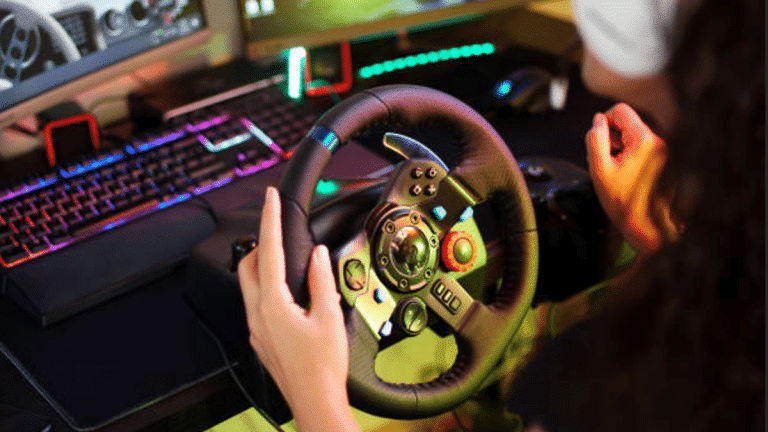Car racing games have been a staple of the gaming industry since its early days. From the simple, pixelated joys of arcade classics to the ultra-realistic simulations of today, the genre has undergone a remarkable evolution in terms of mechanics and gameplay. This evolution has been driven by advancements in technology, changes in player preferences, and the quest for ever-more immersive experiences. In this article, we’ll take a journey through the history of car racing games, exploring how they have evolved from arcade-style fun to highly sophisticated simulations.
Contents
The Birth of Arcade Racing Games
Arcade racing games emerged in the late 1970s and early 1980s, during the golden age of arcade gaming. These games were characterized by their simple controls, fast-paced action, and emphasis on fun rather than realism. Some of the most iconic titles from this era include Pole Position, Out Run, and Daytona USA.
- Simple Controls: Arcade racing games typically feature straightforward controls, often limited to a steering wheel and a few buttons for acceleration and braking.
- High-Speed Thrills: The focus was on delivering adrenaline-pumping experiences, with exaggerated physics and high-speed action designed to keep players on the edge of their seats.
- Fantastical Environments: Many arcade racing games featured fantastical settings, such as exotic landscapes or futuristic cityscapes, adding to the sense of escapism and adventure.
The Rise of Realism
As gaming technology advanced, developers began to explore ways to bring greater realism to car racing games. This led to the emergence of titles that aimed to replicate the look and feel of real-world racing experiences.
- Improved Graphics: With the advent of 3D graphics technology, racing games were able to offer more realistic environments, detailed car models, and dynamic lighting effects.
- Physics Simulation: Developers started incorporating more sophisticated physics engines into their games, allowing for more realistic handling and vehicle behavior.
- Authenticity: Players began to demand greater authenticity from their racing games, leading developers to license real cars, tracks, and even professional racing leagues.
The Shift Toward Simulation
In recent years, there has been a noticeable shift towards simulation-style racing games, driven in part by advances in hardware capabilities and the increasing demand for immersive asia128 gaming experiences.
- Precision Controls: Simulation games place a greater emphasis on precision driving, requiring players to master realistic controls for steering, braking, and acceleration.
- Dynamic Environments: Advanced simulation games feature dynamic weather and track conditions, affecting the handling and performance of vehicles in real-time.
- Realistic Damage Models: Simulation games often include detailed damage models, with cars realistically deforming and breaking apart in response to collisions.
- Professional Esports: The rise of professional esports leagues dedicated to simulation racing games, such as iRacing and Assetto Corsa Competizione, has further legitimized the genre and attracted a new generation of players.
Balancing Realism and Accessibility
While simulation racing games offer unparalleled realism, there is still a place for more arcade-style experiences in the gaming landscape. Many developers have sought to strike a balance between realism and accessibility, catering to a wider audience of players with varying skill levels and preferences.
- Assist Options: Many simulation games offer assist options, such as traction control and anti-lock brakes, to help less experienced players get to grips with the mechanics without sacrificing realism.
- Progressive Difficulty: Games may feature progressive difficulty settings, allowing players to start with simpler controls and gradually increase the level of realism as they gain experience.
- Customization: Players often have the option to customize their gaming experience, adjusting settings such as difficulty, driving aids, and realism to suit their preferences.
The Future of Car Racing Games
Looking ahead, the future of car racing games is likely to be shaped by continued advancements in technology, as well as changes in player expectations and preferences.
- Virtual Reality: Virtual reality technology has the potential to revolutionize the racing genre, offering unparalleled levels of immersion and realism.
- Cloud Gaming: The rise of asia128 cloud gaming services could make high-fidelity racing experiences more accessible to a wider audience, by removing the need for expensive hardware.
- Cross-Platform Play: With the growing popularity of cross-platform play, racing games may become more inclusive and interconnected, allowing players on different devices to compete against each other seamlessly.
- Artificial Intelligence: Advances in artificial intelligence could lead to more sophisticated opponent behaviour in racing games, creating more challenging and realistic racing experiences.
Conclusion
In conclusion, car racing games have come a long way since their humble beginnings in the arcades of the 1970s. From simple, pixelated joys to ultra-realistic simulations, the genre has evolved in remarkable ways, driven by advances in technology and changes in player preferences. Whether you prefer the adrenaline-pumping thrills of arcade racing or the precision driving of simulation games, there has never been a better time to be a fan of car racing games. As technology continues to advance, the future looks brighter than ever for this beloved genre.

